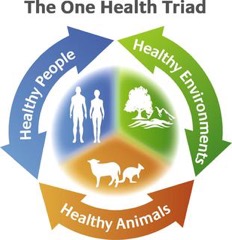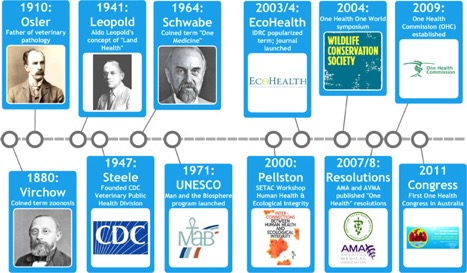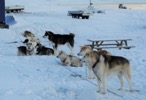The following post is one of a series previewing the research that will be presented at the in Helsinki, Finland (26–30 May 2019).
A guest post by Frances Nilsen
 What is “One Health”?
What is “One Health”?
“One Health” is an organizational framework encouraging interdisciplinary collaborations in education, research, clinical practice, policy, and communication stemming from the recognition that the health of people, animals, and the environment are linked. One Health partnerships are growing internationally, mainly emphasizing prevention of infectious zoonotic diseases (those that can be passed between animals and humans), but the environmental quality connections to human and animal health are often less developed in One Health collaborations.
Across the globe today, there are various complex issues that are at the intersection of the human, animal, and ecosystem health triad. To address these issues, it is imperative that a variety of scientific disciplines and research objectives come together and connect. The One Health framework is a collaborative, transdisciplinary effort to improve health for people, animals, plants, and the environment. The framework centers around the One Health triad of disciplines grouped into human, wildlife, and ecosystem health sciences. Using the One Health approach to research and address environmental issues offers distinct benefits in translating component-specific research linking environmental pathways that affect human health and ecological outcomes. The One Health concept integrates various environmental processes and impacts – from climate change to ecological changes that affect transport of disease agents (including pathogens and chemical contaminants), and diseases, particularly zoonoses. Increasingly, integration of the One Health paradigm requires detailed knowledge of environmental systems and the ways to present these interactions are diverse and increasingly complex. Approaches and outcomes from biology at various levels of organization, human and eco-toxicology, chemistry, quantitative analysis, and modeling combine to inform existing frameworks like life cycle analysis and risk assessment and can help provide more robust solutions to these complex problems.
The “One Health” concept has been around for a long time and has been called by a variety of different names including “one medicine,” “global health,” “planetary health,” “eco-health,” and many others. It is important to note that all these classifications share the same fundamental idea–that all parts of the living world are connected.

One Health timeline taken from the referenced in “SETAC & One Health,” below
SETAC & One Health
SETAC scientists are in a unique position to incorporate the One Health framework into their interdisciplinary research. As part of a worldwide professional organization dedicated to the study, analysis, and solution of environmental problems, we can utilize the One Health Triad to further elevate our work and have a greater impact. SETAC’s science can guide the environmental quality component of One Health partnerships.
At the 29th annual European SETAC meeting, the inaugural EU One Health session will be held– bringing a successful and interdisciplinary topic from SETAC North America to the European geographical unit for enhanced collaboration opportunities. The previous One Health sessions have generated a growing interest in the SETAC community that was highlighted by a published in Environmental Toxicology & Chemistry in 2016. Recently, the One Health initiative has gained substantial traction within the society including the support and involvement of the Wildlife Toxicology, Ecological Risk Assessment, and Human Health Risk Assessment Interest Groups. A One Health plenary lecture was given at the SETAC Africa/Society for Risk Analysis 2019 joint meeting in early May and was met with great enthusiasm.
The One Health session in Helsinki will highlight approaches taken to integrate the One Health framework into different areas of research. The session will specifically highlight SETAC’s approach to integration across the society, the use of a species extrapolation tool to link chemical susceptibilities across taxa, an integrated assessment to better understand PFAS in the environment, and One Health-related lessons learned from the recent Lancet Commission on Pollution and Health. The Helsinki session will also host Dr. Christian Sonne from Aarhus University in Denmark who will assessing the carried risks facing Arctic wildlife populations including exposure to long-range transported industrial chemicals, climate change, and disease. Sonne’s presentation will highlight the veterinary perspective of One Health and ecosystem dynamics and discuss that the One Health approach is necessary to understand holistic ecosystem health inclusive of human populations in the Arctic and beyond.
- Photos courtesy of Christian Sonne
Well- Known One Health Cases
Zoonotic diseases
Zoonotic diseases are viruses, bacteria, fungi, or parasites that can be transferred from infected wildlife to humans and provide a clear link between human and wildlife health. Rabies is the most well-known zoonotic disease that is transferred through the bite of an infected host. According to the World Health Organization, up to 59,000 people die globally from rabies each year with 99% of those cases beginning with the bite of an infected dog. In the United States, the few rabies deaths annually are commonly caused by bats. The rabies virus affects the central nervous system and causes inflammation in the brain. The incubation period for the virus is 12 weeks, which can make identification of the infected animal difficult. Fortunately, there are vaccinations to prevent the transfer of rabies from domestic animals to humans. Other known carriers of the rabies virus are ferrets, cats, cows, horses, goats, coyotes, foxes, and raccoons.
Harmful Algal Blooms
Harmful algal blooms occur when colonies of algae reproduce at a rapid pace and consume the available oxygen in the water as they decay. Some species of algae also produce toxins that can kill fish, birds, and mammals. Blooms can occur along any coastline but are more frequent in certain areas where conditions favor rapid algal growth. However, with climate change and increasing nutrient pollution, the National Oceanic and Atmospheric Administration (NOAA) predicts that blooms with occur more frequently and in areas that have not previously experienced a bloom. The effects of harmful algal blooms are several-fold: the consumption of infected fish and shellfish can cause health problems in humans, the bloom can impact local recreation at the coastline, as well as economic impacts occurring from loss of seafood sales, lost wages for fisherman, and reduced coastal tourism activities.
The Future of One Health
The One Health framework offers an attractive structure to mold existing research projects into and identify collaborations between scientists working in the same One Health niche, which is often wider than a singular discipline niche. The One Health framework can provide a means of extending the scope of current projects to make a greater impact for environmental, wildlife, and human health communities.
Session information: One Health: Interdisciplinary Solutions for Complex Problems
Wednesday, 29 May | 13:55–15:30 | Room 208



